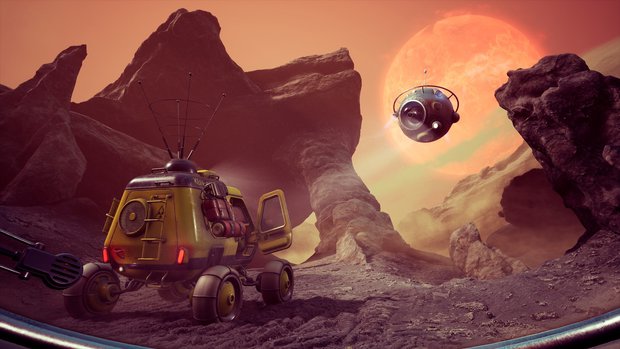The Invincible review

- 0 Comments
Powerful storytelling vehicle inspired by Stanisław Lem novel features as much science as fiction
It’s a rare feat when a game not only hits all the right notes and manages to engage with me cerebrally and emotionally, but actually piques my interest to delve deeper into its source material after the credits have rolled. I’m happy to report that this was my exact experience with Starward Industries’ The Invincible. Based on Polish author Stanisław Lem’s hard sci-fi novel of the same name, the game tasks us with investigating an alien planet, which by itself is hardly an original concept, but does so from a refreshingly dedicated scientific mindset, one more concerned with sober logic than fear and panic. While gameplay itself is rather simple – nearly on rails, even – the beautifully presented narrative experience is fascinating and well worth experiencing.
First off, let’s address the spaceship-sized elephant in the room: despite sharing its title, the game isn’t merely a retelling of its predecessor. In fact, the titular Invincible herself – one of the largest spaceships in the fictional Cosmosolidary Alliance – barely features in the game, and her expected arrival acts more as a ticking clock for the game’s actual cast of characters. Players take on the role of Dr. Yasna, an astrobiologist serving on an opposing faction’s ship, the Interplanetary Commonwealth’s Dragonfly. While the game preserves the novel’s setting, themes, and the delicate rivalry between the Alliance and the Commonwealth, with all the neurotic mistrust it carries with it (think of it as the Cold War’s Soviet vs. Western Bloc dynamic), it is actually a prequel to the events of the book, telling the story of what happens on the planet Regis III prior to the Invincible’s arrival, which heralds the start of the book’s narrative.
In broad strokes, the crew of the Dragonfly is homeward bound after successfully completing a number of interstellar scientific research missions, when they are unceremoniously awakened from cryosleep for one last mission: investigate the nearby Regis III, which is mysteriously devoid of life despite having an oxygen-rich atmosphere. Having received intelligence about the Alliance’s interest in the planet – in fact, the Invincible is already on its way, and due to arrive in a matter of days – the Dragonfly’s crew hurriedly sends a party planetside to begin investigations. Initially left behind (with no signs of indigenous life on the surface, there should be no need for an astrobiologist to tag along), Yasna eventually boards a landing vessel and follows behind when the rest of the team discovers some aquatic lifeforms and immediately goes radio silent.

However, in what seems like an unnecessary narrative device, most of this context is initially absent. Instead, the game first fades in on Yasna already having landed on Regis III, alone and unable to remember how she got there. Her bout of amnesia doesn’t really do anything to drive the mystery forward and is one of my only nitpicks with the storytelling here. You’ll have to spend the first thirty minutes or so discovering your whereabouts and reestablishing communication with Yasna’s commanding officer, Astrogator Novik, still aboard the orbiting Dragonfly. But once communications are up and running again and flashbacks have filled in any narrative gaps, the plot turns to far more interesting and fertile grounds, leaving me scratching my head at why these lost memory beats were included at all. (There are some minor story-related reasons hinted at much later on, but a small tweak in delivery could have surely circumvented the inclusion of this unnecessary trope.)
Thankfully, it doesn’t take long for the storytelling ship to be righted. Much of the game sees Yasna travel on foot, in first-person perspective, across various stretches of Regis III’s surface. While it’s not the most environmentally diverse setting out there – Yasna lands in and spends the majority of her time in a rocky, desert-like region – her professional curiosity means there are always interesting discoveries to make along the way, whether it’s observing the unusual natural rock formations or using a metal detector to scan for subterranean metal traces. True to her mission, the scientist makes her way to the Dragonfly’s research camp to check on her colleagues, and from there is pulled onward as the tale unfolds. Without spoiling anything, the mysteries continue to stack up as the plot thickens, while you explore and come into contact with the enigmas found on Regis III – as it turns out, the Alliance’s interest in the planet is anything but purely academic.
It seems important to note that neither the game nor Yasna herself ever fail to approach her findings – such as what passes for Regis III’s local flora – from anything other than a scientific perspective. Being an astrobiologist, Yasna has a keen interest in analyzing the discoveries she makes, and she and Novik will heartily discuss and theorize about any number of topics. At one moment, they may go back and forth attempting to pin down the evolutionary ladder of a certain type of local plant growth, then later a reactivated observation drone will cause the pair – with some player input in the form of dialog choices – to postulate about the developmental trajectory of artificial intelligence and how it will impact future scientific research.

The writing and how it’s implemented here is smart yet accessible, and does wonders for the character development of these two whom you’ll be spending the majority of your time with. It’s also an invaluable tool for filling the early gameplay segments in particular with something beyond the act of walking from point A to point B; something to listen to while the story’s main thrust hasn’t quite ramped up yet. Still, you need not fear that scientific analysis (as engaging as it may be) is all that The Invincible has to offer, as later developments provide intriguing plot points in spades.
Regis III, or at least what we get to see of it, is made up almost entirely of barren terrain and stony cliffsides. It’s an arid place with little variety, though that’s not to say it’s a boring or one-note setting: scaling rocky outcroppings, edging along steep precipices, and navigating treacherous terrain provide plenty of things to attract your attention. The game aims to, and succeeds in, establishing a rather lonely atmosphere, with Yasna traversing these bleak landscapes laboriously on foot or, in a few instances, via a rover-style vehicle. The steady stream of self-talk she engages in along the way, as well as the remote conversations with Novik back on the ship, only serve to highlight her solitude, which can’t help but rub off on you in effective ways. Novik is a seasoned leader, with years of experience to call upon, not to mention the advanced technology available to him on the Dragonfly, so the presence of his voice alone can seem like a reassuring lifeline. It also makes his occasional absence – for example, when entering an underground cave network temporarily disrupts radio contact – all the more impactful.
It’s helpful, then, that the voice acting is quite good overall, particularly Yasna and Novik. There is one scene that especially stands out to me, an amazing moment of such vulnerability, such gorgeous character building that it instantly seared itself into my mind. Following a series of harrowing near-death scrapes, Yasna manages to escape danger by climbing into a rover and putting the pedal to the metal. Unfortunately, this also puts her in the middle of a violent lightning storm, rain pouring down, racing across unknown landscapes in the dead of night.

Eventually, Yasna manages to find shelter in a protective cave and decides to wait out the storm. She shuts off the rover’s engine and attempts to get comfortable, hoping to get some rest. But with adrenaline still flooding her system, she is unable to sleep, so she asks Novik to continue to talk to her, offering her the comfort of his presence while also lulling her to sleep until gradually, ever so slowly, the image begins to wink in and out as Yasna’s fatigue gets the better of her and she dozes off. It’s a beautiful depiction of the human need for company, a loneliness so extreme that even something as simple as a familiar voice can become desperately needed. It’s essentially a nothing scene, but one that should be painfully familiar to everyone, and I love that the game is brave enough to take the road less travelled for a moment.
The well-done voice acting isn’t the only area where the game’s presentation shines, though it will be more easily appreciated by those with an affinity for the golden era of pulp sci-fi. The design team has done a fantastic job modeling the look and sound of the period when The Invincible’s namesake was conceived. From the very outset – I’m talking title screen – it’s impossible to escape the sixties/seventies-era hard sci-fi vibes, evident in everything from the spacey synth-tone soundtrack to the visual depictions of the tech and gear used in-game. While there aren’t any particular standout musical compositions, the score perfectly captures that surreal Kubrickian feeling of detached unease. Meanwhile, the aesthetic perfectly captures the hardware store quality of the props and sets, self-aware but reverent all the same, with oversized plexiglass bubble helmets, vacuum cleaner “air hoses,” and scores of unnecessary blinking lights.
If there’s one trap The Invincible falls prey to, it’s that it puts up absolutely zero roadblocks for you to progress through it. That means it’s highly accessible to even the most puzzle- or action-averse gamer out there, but it does come at the cost of any sort of challenge whatsoever. To be clear, you are always in control of Yasna and can explore all you like; it’s just that there’s little reason to do so, and not a whole lot to stumble upon if you do, outside of a handful of optional things in the game’s latter half just to throw completionists a bone without adding much to the actual worldbuilding. The few “puzzles” generally take the form of operating one device or another, which is always accompanied by step-by-step on-screen instructions guiding you in which button to press or switch to flip next. Interacting with the analog technology in this way is engaging, just not remotely challenging.
A small amount of agency is nonetheless yours, where you make a handful of choices that will have an impact on the game, such as whether a crew member makes it off-world alive or not, or which path to follow to reach an objective. There are even multiple endings, though these mostly branch off of some end-game decisions that can be easily altered by reloading the final checkpoint and trying a different approach. In a neat touch, key moments and choices are reflected in unlockable comic book panels that tell the story of Yasna’s journey – including the decisions you make – in a visual novel accompaniment to the game.
Final Verdict
The Invincible is a delightfully refreshing take on the interstellar space thriller. Devoid of hackneyed jump scares or spooky plot lines, it instead focuses on telling a smart, scientific story about the evolution of nontraditional life, and what happens when humans decide to interfere in an arena they have no real understanding of. It finds thrills in the magic of the unexpected rather than in high-octane set pieces. It’s well-written, nicely performed, and presented as a love letter to the golden age of sci-fi in which Lem’s novel was originally conceived. While it won’t scratch any serious puzzle itches, it managed to trap me in its orbit via truly gripping storytelling and a charming presentation, and inspired me to follow up by delving into the original novel that inspired it.
Hot take
Based on the 1964 hard sci-fi novel of the same name, The Invincible tells a mature, thought-provoking story about a research team’s discoveries on a distant planet. While the gameplay isn’t much to write home about, the smartly presented experience is nevertheless out of this world.
Pros
- Intelligent plot that values scientific curiosity above cheap thrills
- Stellar writing fleshes out characters very well
- Excellent voice work by the main cast
- Sights and sounds of sixties-era sci-fi are replicated perfectly
Cons
- No sign of life in the puzzle department
- Choices and exploration don’t have as much impact as they could
Pascal played The Invincible on PlayStation 5 using a review code provided by the game's publisher.










0 Comments
Want to join the discussion? Leave a comment as guest, sign in or register in our forums.
Leave a comment